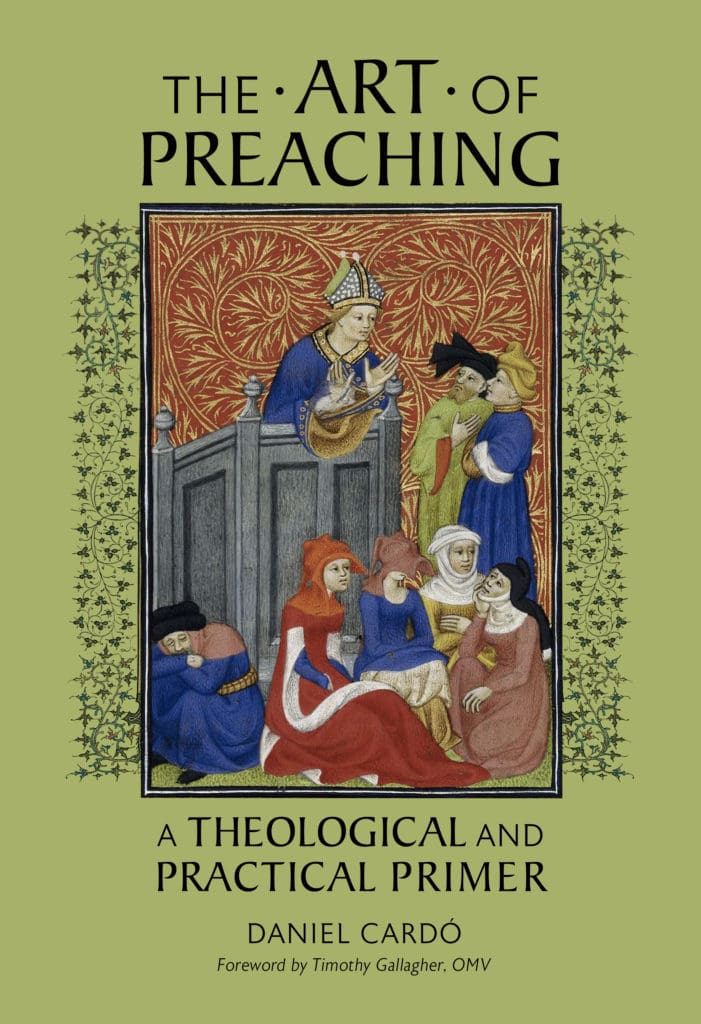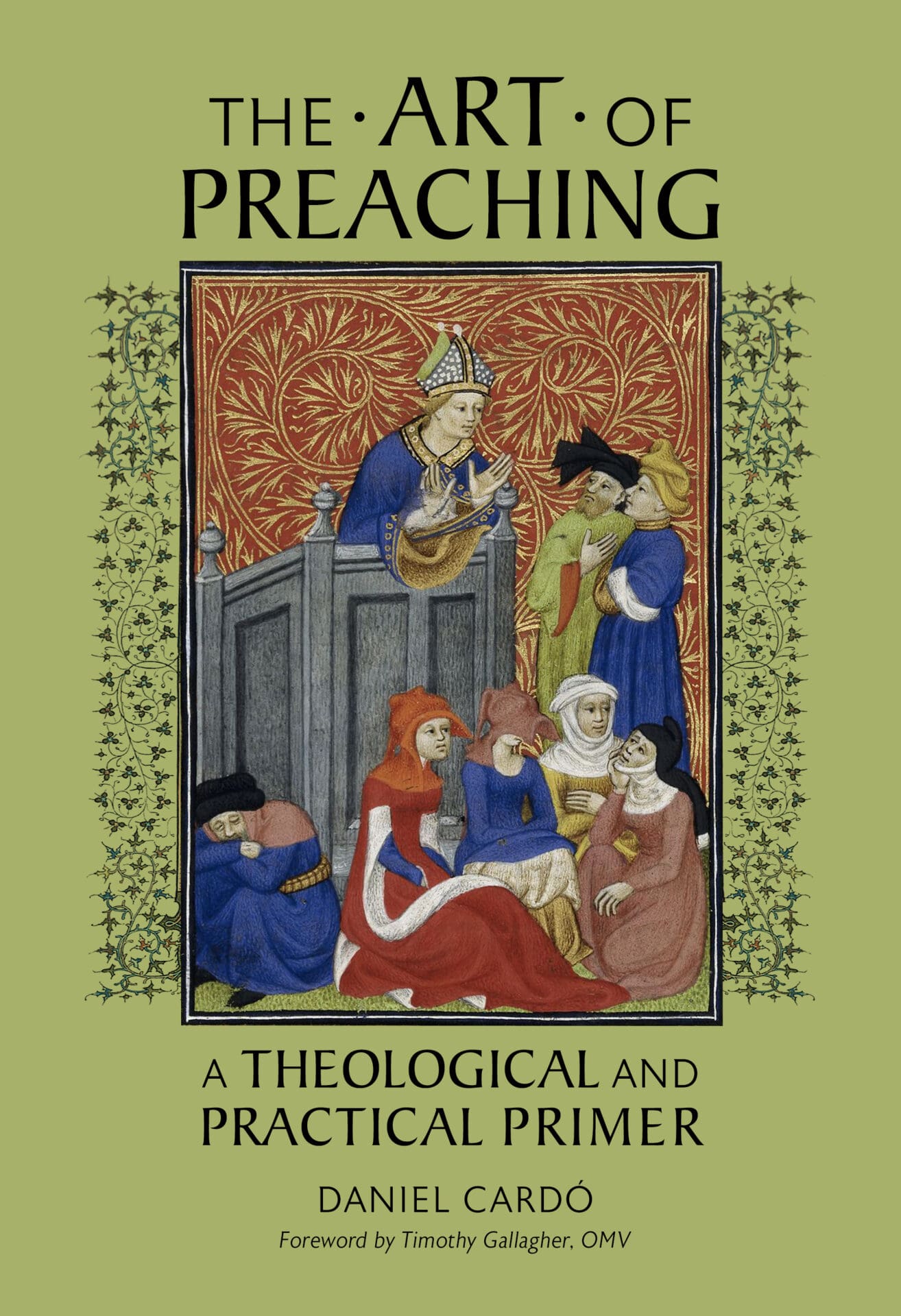Pope Benedict XVI’s 2007 apostolic exhortation on the Eucharist, Sacramentum Caritatis, places a premium on the role played by the homily in the Mass—and gives the Church’s homilists a less than favorable review regarding the current state of homiletics. He writes, “Given the importance of the word of God, the quality of homilies needs to be improved” (46). I thank God that we have a new book that can assist in remedying this significant need in the Church.

The author, Father Daniel Cardό, holds the Benedict XVI Chair of Liturgical Studies at Saint John Vianney Seminary in Denver and is Pastor of Holy Name Parish. He dedicates his latest book to his students and his parishioners at those two places respectively. The Art of Preaching: A Theological and Practical Primer demonstrates the wisdom and skill of someone with much experience of preaching and of teaching preaching. The book is clear in structure and layout, balanced in approach, incisive in judgment, and extraordinarily helpful. This review will touch upon each of these characteristics.
Clarity in Structure and Layout
Father Cardό begins the book with an introduction titled, “Why Preach?” Honest about deep problems in the Church, he knows that “It can seem that the people of God are drifting further from our Lord every day, and indeed the statistics say so” (p. 5). The Church has been proposing a new evangelization, and Cardό believes that the future is full of hope because of God’s goodness. The author writes, “The springtime that we need will come from an unpretentious movement: to love Christ, and to know how to speak about him. This book hopes to offer a contribution for that future” (p. 5).
Not a scholarly manual but a user-friendly guide, the book offers the art of preaching through two principal considerations. Part I gives the Foundations of Preaching in nine chapters, and Part II contains a Homiletics Reader, with Chapters 10–23 offering selections from sermons of model preachers in the Church from the fourth-century St. Gregory Nazianzen to our current Holy Father, Pope Francis.
Part I has nine chapters, each about a dozen pages in length, arranged in logical order. Each chapter ends with Questions for Reflection and Conversation, a tool that can be handy for a classroom or group discussion. After the first chapter’s emphasis on “Homiletics: The Challenge and the Opportunity,” the book gives chapters dedicated to public speaking and a theology of preaching. After Chapter 5’s detailing advice from a spectrum of the faithful who listen to preaching, the book gives counsel about preparing a Sunday homily and its delivery. Chapter 8 focuses on the brilliant example of St. Augustine, and the last chapter of Part I extols preaching as locus theologicus, a place of authority for thinking about God.
A consummate teacher who can explain difficult concepts in an intelligible way to students, Father Cardό takes that final chapter of the first part of the book to show that those called to preach are called to be theologians. He explains the term locus theologicus, borrowed from the 16th-century Dominican Melchior Cano, as a “theological place” in three respects: a place for encountering the Word, a place for the celebration of God’s Word, and a place to listen to theology.
Father Cardό introduces Part II by explaining that he is offering “a sample of exemplary homilies for personal reflection and group discussion, because we need to learn from the best” (p. 123). He does not intend for readers to copy what great preachers have done in Church history, but rather to learn from them. The 14 homilies selected for the book, chronologically arranged, communicate an amazing range of homiletic styles. Readers can hear from St. Gregory Nazianzen, St. Ambrose of Milan, St. John Chrysostom, St. Leo the Great, St. Bernard of Clairvaux, St. Thomas Aquinas, St. Charles Borromeo, Bishop Jean-Bénigne Bossuet, St. John Henry Newman, Father Ronald Knox, St. Paul VI, St. John Paul II, Joseph Cardinal Ratzinger-Benedict XVI, and Pope Francis. Like the chapters in Part I, each chapter of Part II concludes with thought-provoking questions.
The book holds an admirable clarity in design and argument, and it is indeed a “primer,” a starting point for the art of preaching.
Balance
One of the qualities of Father Cardό’s book that has most impressed me is its balance. It is both deeply theological and eminently practical. It offers the research of Church history, with special attention to the Fathers of the Church, while responding to the needs of the present time. It gives appreciative readings of the magisterial teachings of the post-Vatican II pontificates, and it offers opinions from those in the pews. The book is very Catholic, steering clear of useless polemics but recognizing grave problems and the need to proclaim the Gospel of Jesus Christ as the ultimate solution to these problems.
As an example of the balance which characterizes the book’s overall approach, in Chapter 2, “Homiletics and Public Speaking,” the author recognizes that preaching is a species of oration—public address, and so its exploration of the natural virtues of a good speech precedes Chapter 3’s Theology of Preaching. (Grace does not destroy nature, but presupposes it, after all.) Within his treatment of public speaking, Cardό has a dual focus: how to employ the principles of classical rhetoric within a contemporary setting. In classical rhetoric, he draws upon Aristotle for the three main modes of persuasion to cause pistis (trust) in an audience: logos (appeal to reason), ethos (appeal to virtue), and pathos (appeal to emotion). Like Augustine, he draws from Cicero the three necessary objectives of teaching, delighting, and swaying. He also borrows from Quintilian the canons of rhetoric which must be kept in mind during the composition of the homily: invention, arrangement (with introduction, narration, argumentation, and conclusion), style, memory, and delivery. Cardό briefly explains each.
After all that foundational work, Cardό looks at the popularity of TED Talks as a contemporary example of successful oration. Relying upon TED Talks’ head and curator Chris Anderson, who has written the official TED guide, he finds that preachers can learn much. For example, every TED talk needs a “throughline,” a connecting theme that keeps all the parts together to help produce the overall meaning. Cardό writes, “I am convinced that if this one practice were implemented by all preachers, we would witness a quick and significant improvement in the quality and timing of homilies” (p. 33). Underscoring that there are significant differences between TED talks and preaching, the author offers his readers some important take-aways. Every homily needs a personal connection, but any talk that conveys egocentrism will be ineffective. Powerful stories help, as homilies, like TED talks, need to elicit interest from hearers. Ultimately, preachers are meant to be persuasive and to fill the church with awe and enthusiasm—though not for the speaker as such, but for his subject, Jesus Christ.
Incisive Judgment
Father Cardό’s book not only offers balance, it communicates incisiveness in judgment. The author is an accomplished liturgical scholar. He has been markedly influenced by the theology of Joseph Ratzinger-Benedict XVI, and his previous books include The Cross and the Eucharist in Early Christianity: A Theological and Liturgical Investigation (Cambridge University Press, 2019). Whether he gives speculative considerations or practical advice in The Art of Preaching, Father Cardό offers keen insights that support a rich appreciation for the mysteries of faith in homiletics for the real needs of today.
For example, from a theological perspective, Chapter 4 helps the reader understand preaching through an incarnational approach. “It is no exaggeration to say that communion with Christ the incarnate Word is the real foundation for good preaching,” the author writes, “which in the end consists in accepting the Word in our lives, learning from him how to proclaim the good news, and learning to do so with him. Only in Christ are we truly capable of knowing God, of whom we preach; and of knowing our people to whom we preach” (p. 52, original emphases).
Father Cardό continues to spell out this incarnational logic, modelled on the one divine person of Jesus Christ, who has both divine and human natures. Christ offers those conformed to him by holy orders a capability of acting in both the divine and human worlds. Father Cardό summarizes that “in communion with Jesus, the preacher becomes capable of speaking of ‘two worlds,’ translating God to his people, and bringing his people to God.”
But Father Cardό also offers some practical wisdom along with the theological kind that appears in his book. He knows that preachers will have different ways of delivering a homily, but he insists that some qualities must be present. One is eye contact. “A homily is interpersonal communication, an experience of communion and conversation. Because of this personal character, the homilist normally looks at his people when he preaches. Eye contact is one of the most natural and evident expressions of this personal aspect of preaching: naturally, we look at those we are addressing. We must avoid certain defects as we preaching, such as simply reading from a text, looking at a wall, or closing our eyes” (p. 95).
Furthermore, his wisdom on practical matters also touches on uniquely contemporary questions: “Is there room for using videos or presentations on screens during the homily?” He writes in response “Mass should be one of the few oases in which the soul can rest from screens” (p. 97). It is important to maintain the sacredness of the liturgy in a way that separates the Mass’s homily from the latest video technology.
Extraordinary Helpfulness
Father Cardό has done a remarkable service for the book’s readers. As a priest in the Order of Preachers who has been blessed to teach preaching in Nairobi, Kenya and Washington, DC, and who loves to write about patristic preaching, I have found The Art of Preaching exceedingly advantageous. In the last several months, it has been an important part of my ongoing formation as a preacher, and I have already cited it in my writing. It can be an influential book for those in initial formation to be preachers and for those in ongoing formation.
For student and experienced preacher alike, Father Cardό returns preaching to the breathtaking basics of salvation. Listen to his words: “What we preach is simple: Jesus is Lord. Of course, simple does not mean shallow or repetitive. The depths of the simplicity of God are infinite” (p. 45). The author stresses that the greatest preachers have varying styles, “and yet their voices form a wonderful polyphonic song to the Lord, magnificently blended by the harmony of love. Is it a coincidence that the most memorable homilies of our tradition were preached by saints?” (p. 450).
I highly recommend The Art of Preaching to all bishops, priests, deacons, and those in formation for Holy Orders. Additionally, those who do not practice liturgical preaching but want to support its renewal may also read this book with great profit—and they may want to give it as a gift to preachers. I, as one preacher, am grateful that it was given to me.
Father Andrew Hofer, O.P., teaches on the Pontifical Faculty of the Immaculate Conception, Dominican House of Studies in Washington, DC, where he serves as editor of The Thomist. His publications include Christ in the Life and Teaching of Gregory of Nazianzus (OUP, 2013) and The Word in Our Flesh: The Power of Patristic Preaching (CUAP, forthcoming). He is presently co-editing The Oxford Handbook of Deification (OUP), The Cambridge Companion to Augustine’s Sermons (CUP), The Pastoral Theology of the Early Church (CUAP), and Thomas Aquinas as Spiritual Teacher (Sapientia Press).


